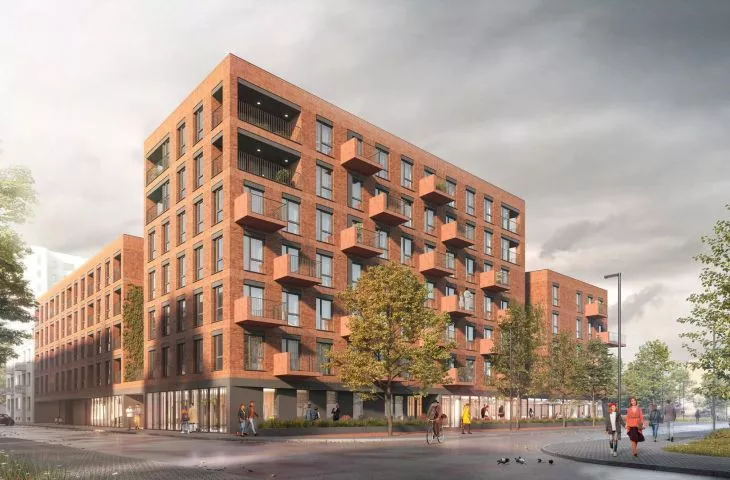On the site of the former "Adamczewski and S-ka" Soap and Candle Factory, operating since the 1920s on Grodno Street in Warsaw's Praga district, a new development is under construction - a multi-family residential building designed by the TZA studio (awarded last year in the competition for the Architectural Award of the President of Warsaw).
The body of the building is broken into three segments standing on a common plinth.
© TZA
The building is made up of three parts - two of them are arranged in an L-shape, while the third diagonally encloses the layout. A one-story pedestal housing services will surround the courtyard, while three separate residential segments will be connected by balconies-arches. The designed building, as emphasized by the authors of the project, although its shape and materials are to refer to the characteristic buildings of Warsaw's Praga district, in details, elevation drawing and functional solutions it will be unambiguously contemporary.
location plan
© TZA
Ola Kloc: What was the priority for the investor?
Aleksandra Targońska: The investor wanted the building to become a seed of change in this part of Warsaw's Praga district. It was clear to all parties involved in the project that a sizable section of the pre-war, compact frontage of Grodzienska Street has a great chance of becoming an interesting part of the city over time, and that the new building must set high standards for subsequent transformations in the immediate neighborhood.
Ola: What was the biggest challenge in this project, and what are you most satisfied with?
Alexandra: The challenge was to develop a relatively small plot of land in a way that would be efficient on the one hand - this is a commercial venture, after all - but at the same time in such a way as to provide attractive views and good sunlight for the apartments. We are pleased that we were able to implement the idea of breaking up the body of the building into three segments standing on a common plinth. They are separated by gaps that let in light and allow us to frame the surrounding, changing buildings. Spacious bridges spanning over these "slits" will certainly be a great asset to the apartments, especially now that we so appreciate each loggia and balcony. The remaining balconies have been designed as dyed-in-place prefabricated elements with a distinctive "L" shape - their recurring form on the facades will be the second distinguishing feature of this building. We are also very pleased that the carefully designed courtyard will not be an enclosed space - it will be possible to walk through it, shortening the route towards the subway station.
The courtyard surrounds a one-story pedestal housing services
© TZA
Ola: The building was constructed on the site of the former Adamczewski and S-ka Soap and Candle Factory, how did the history of this plot influence the character of the new building?
Alexandra: When we started working on the project, the former factory building was already heavily transformed and did not represent much value, so it was not a strong reference for us. We focused on designing a contemporary building that would respectfully relate to the context by relating in scale to the street frontage, using materials characteristic of Prague's post-industrial heritage and shaping an open courtyard that we hope will be an attractive neighborhood space.






































